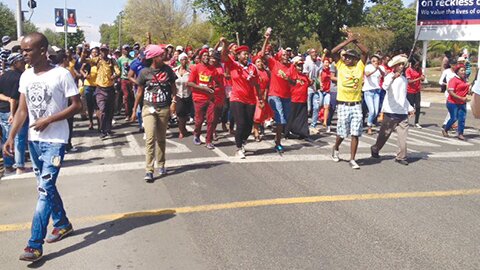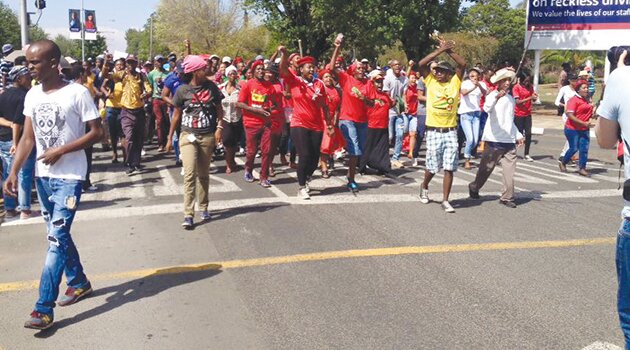Higher education hangs in the balance


Protesting university students … A wave of often violent protests by students last year forced university authorities to scrap planned fee hikes
In this expose Suellen Shay, an associate professor with the University of Cape Town’s centre for higher education development, looks at the four possible ways things might pan out:
Higher education in South Africa is at another crossroads. Students have put pressure on the state to offer “fee-free” education to all following their success last year in securing a zero increase in fees form 2015. But the battle over what fee structure is appropriate for the country is far from over.
In the wake of protests, and government’s concession on increases for this year, a presidential fees commission of inquiry was set up. It is due to release its report by the end of the year. In the meantime universities are braced for student action when government announces its plans for fees in 2016.
All this is happening against the backdrop of an economy that is expected to grow by zero percent this year. This means that the government is unlikely to provide substantial additional funding for higher education.
This will exacerbate the financial distress already being felt by institutions. So what choices does the country have? I have prepared some scenarios that set out possibilities.
But first, some context.
The challenge
In South Africa the number of enrolments has nearly doubled from approximately half a million in 1994 to close to a million by 2014 – an increase in participation rate from 12 to 20 percent in 2013. This means that historically underrepresented groups now make up the overall majority (83 percent). It is good news: we have made progress towards equity of access.
But these gains have not translated into equity of outcomes in terms of students completing their qualifications. Roughly a third of those enrolled will have dropped out in their first or second year, and between 40 and 50 percent will not graduate at all.
The inequalities are starkly evident when we compare the drop-out rates for the 2008 bachelors’ cohort by race (using the apartheid classifications, which are still used to monitor redress): black African students (34 percent), coloured students (37 percent), Indian students (29 percent) and white students (21 percent).
In response to the crisis, the state is committing close to R1 billion (about US$71 million) per annum from 2017 to 2020 as “ear-marked” funding to support greater efficiency of teaching and learning. The purpose of these funds is to address the imperatives of equity and quality.
Possible scenarios
Scenarios are stories about how the future might unfold. They are theoretical reductions of complex variables that are intended to provoke discussion and debate about strategic choices. The scenario thinking process selects some of the trade-offs or strategic choices that then constitute possible futures.
There are currently a number of strategic resource choices that the sector faces. The one is the extent to which the state increases financial aid to students. The other is the extent to which the state invests in improving the effectiveness of teaching and learning.
If we put these two into a matrix, we end up with four possible future scenarios. These are:
a) An ideal future in which government increases financial aid to students and investment in teaching and learning effectiveness.
b) An elite future in which government decreases financial aid, but increases investment in teaching and learning.
c) A wasted future in which government freezes or cuts back on financial aid and invests little in teaching and learning;
and,
d) A high-waste future in which government increases financial aid but decreases investment in education.
All scenarios involve assumptions. For this exercise it is assumed that:
i) the students admitted are academically capable.
ii) The state’s educational investment yields improvements in the effectiveness of teaching and learning, resulting in better retention and increased graduation rates, and.
iii) There is no substantial additional state funding to work with, so any increases require cutting some existing budget.
These assumptions are debatable, as are the scenarios they produce. This is the point of scenario thinking.
The ideal future
In this scenario, given the state’s increase in financial assistance and investment in teaching and learning, students are admitted to university irrespective of their socioeconomic status and there is a good chance they will successfully complete their degrees.
From the point of view of the system, because the financial and academic obstacles have been removed, there is an increase in participation rates and equity of access and outcomes.
This future is, in fact, South Africa’s official future, enshrined in policy since the 1997 white paper, which promised increasing participation rates, equity of access and equity of outcomes in an efficient system.
The elite future
In this scenario, students gain formal access to higher education if they can afford it. Given the chance of a reasonably good schooling background and the state’s educational investment, they are likely to complete their studies.
From a system point of view, the reduced state funding for financial aid would result in a low participation rate with low equity of access and outcomes for socioeconomically disadvantaged groups.
Over time, given the demography of South Africa and the growth of the black upper-middle class, this system would be racially diverse with a black majority. The system would be reasonably efficient, resulting in a highly elite higher education system.
Waste futures
The remaining scenarios are both waste futures, given that no investment is made in improving the effectiveness of teaching and learning, which means completion rates are poor. The difference in the two scenarios is the state’s provision of financial aid.
In the waste scenario, the state freezes or reduces its current contribution to financial assistance. This means students gain formal access to higher education if they can afford it, but their chances of succeeding will largely be determined by the quality of schooling. There is limited equity of access, no equity of outcomes and poor efficiency.
In the high-waste scenario the state increases financial aid. Students in this scenario will gain formal access irrespective of their socioeconomic status, increasing the participation rate and equity of access. But given the lack of investment in improving the effectiveness of teaching and learning, there is a high probability that they will not successfully complete their studies. This makes for a highly inefficient system.
Where is South Africa now?
I would propose that South Africa currently sits somewhere in the waste scenario. The state’s investment over the past 20 years has produced an expanded system with greater equity of access, but it is far from achieving equity of outcomes. The result is inequitable and inefficient.
If there is a significant increase in financial assistance to talented but underprepared poor students, but there is not a significant educational investment to improve completion rates, South Africa’s trajectory moves towards the high-waste scenario.
The state’s most pressing transformation priority needs to be investing in carefully targeted and monitored educational interventions that improve the effectiveness of teaching and learning, reduce drop-out and improve graduation rates. An example would include a revised undergraduate curriculum that is more fit-for-purpose by catering for a much greater diversity of educational preparedness.
What we must avoid is substantially increasing financial aid at the expense of greater efficiency – otherwise more students will get financial access to higher education but their chances of walking out with a degree are not good. – The Conversation
